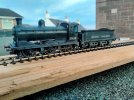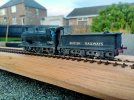You are using an out of date browser. It may not display this or other websites correctly.
You should upgrade or use an alternative browser.
You should upgrade or use an alternative browser.
Some weathered models
- Thread starter Scubaidh Dubh
- Start date
paulc
Western Thunderer
Definitely spray for models , i only brush it on timber .Thanks Paul.
The Ronseal I used was polyurethane based I believe. I think it may have been a little on the dense side so other options are always useful to explore. I can see it being excellent for etched carriages and locos. My issue with the denseness suggests that spray application would probably be a better way forward than applying via brush.
Davy.
Scubaidh Dubh
Western Thunderer
Davy, this is now my go-to for finishes.

VMS - Vantage Modelling Solutions | VMS Varnish HD
Line comprises three easy to spray (no thinning required) types: deep matt, silky satin and classic gloss. VMS modelling Varnishes are 100% translucent - no white traces!www.vms-supplies.com
It is also what we are recommending from Scottish Wagon Works as it works great with our transfers.
John
Thanks John.
Ordered some gloss and matt.
Some testing will be conducted on arrival.
John Duffy
Western Thunderer
Watch their video. We put a link on our instructions-
It is important to keep it wet when applying. I’ve found it to be great.
John
It is important to keep it wet when applying. I’ve found it to be great.
John
adrian
Flying Squad
Quite expensive at the moment and only appears to be available in the US and Canada at the moment but this looks to be an interesting development if other companies bring similar products to market. A UV curable varnish in gloss, satin or matt - cures in minutes under UV source.One of the things I'm currently looking at is the gloss base finish. It's near impossible to really portray a loco well without some kind of representation of it -even under heavy weathering it's rarely completely hidden. For years I have used Klear/Future to provide that basic effect but I feel it has its limitations in terms of durability with some of the techniques I'm using.
I tried Ronseal at one point but that led to problems with the black V2 that took a great deal of work to get under control - I think that's a better starting point for a kit built and painted loco rather than an RTR model.
The search is on for something else that provides a suitable but perhaps more durable effect.
Scubaidh Dubh
Western Thunderer
Thanks John.Davy, this is now my go-to for finishes.

VMS - Vantage Modelling Solutions | VMS Varnish HD
Line comprises three easy to spray (no thinning required) types: deep matt, silky satin and classic gloss. VMS modelling Varnishes are 100% translucent - no white traces!www.vms-supplies.com
It is also what we are recommending from Scottish Wagon Works as it works great with our transfers.
John
I just ordered the gloss and matt so I shall see how I get on with them.
Davy.
paulc
Western Thunderer
Hi Adrian , my thought when i watched the video was that its very thick and would need thinning for model use so what would you use to thin it . Given that it dries using UV I'm not sure what thinner if any would work .Quite expensive at the moment and only appears to be available in the US and Canada at the moment but this looks to be an interesting development if other companies bring similar products to market. A UV curable varnish in gloss, satin or matt - cures in minutes under UV source.
Lot's of questions with no answers I'm afraid .
Scubaidh Dubh
Western Thunderer
While it's good quality stuff, I'll be honest and admit I'm struggling to use it neat as recommended. The gloss seems to go on way too heavy so until I figure out where I'm going wrong with it, I'm applying it by brush, notably thinned down as well to avoid brush marks. I think I probably need another compressor that I can control the pressure more easily with and a wider needle and nozzle specifically for the job.
The demos on YouTube show it to be decent enough, but it's obviously something I need to master.
Still, given I'm redundant from tomorrow and taking a month off before I look for anything else, I'll have time to investigate!
Davy.
The demos on YouTube show it to be decent enough, but it's obviously something I need to master.
Still, given I'm redundant from tomorrow and taking a month off before I look for anything else, I'll have time to investigate!
Davy.
paulc
Western Thunderer
What are you thinning it with ? Curiosity makes me ask .While it's good quality stuff, I'll be honest and admit I'm struggling to use it neat as recommended. The gloss seems to go on way too heavy so until I figure out where I'm going wrong with it, I'm applying it by brush, notably thinned down as well to avoid brush marks. I think I probably need another compressor that I can control the pressure more easily with and a wider needle and nozzle specifically for the job.
The demos on YouTube show it to be decent enough, but it's obviously something I need to master.
Still, given I'm redundant from tomorrow and taking a month off before I look for anything else, I'll have time to investigate!
Davy.
While it's good quality stuff, I'll be honest and admit I'm struggling to use it neat as recommended. The gloss seems to go on way too heavy so until I figure out where I'm going wrong with it, I'm applying it by brush, notably thinned down as well to avoid brush marks. I think I probably need another compressor that I can control the pressure more easily with and a wider needle and nozzle specifically for the job.
The demos on YouTube show it to be decent enough, but it's obviously something I need to master.
Still, given I'm redundant from tomorrow and taking a month off before I look for anything else, I'll have time to investigate!
Davy.
Scubaidh Dubh
Western Thunderer
Scubaidh Dubh
Western Thunderer
I wasn't entirely happy with the gloss finish on the 08 so I took it off with neat thinners and a stiff rubbing brush, followed up by cotton buds and started again.
This time I'm a lot happier with the effects which more accurately portray the well used but well kept look of Kittybrewster and Ferryhill pilot locos.
I should take a layout shot of it for better context really.
Davy.



This time I'm a lot happier with the effects which more accurately portray the well used but well kept look of Kittybrewster and Ferryhill pilot locos.
I should take a layout shot of it for better context really.
Davy.



John Duffy
Western Thunderer
That is very nice. A Kittybrewster engine?
Scubaidh Dubh
Western Thunderer
I believe it was, John.That is very nice. A Kittybrewster engine?
Aberdeen pilots in the '60s seem to have been well turned out. Both sheds seemed to make the effort with them at this time but particularly Kittybrewster.
Davy.
Scubaidh Dubh
Western Thunderer
Davy,
Given your skill and recent redundancy - perhaps you should do commissions?
Steve
This is something I have been doing for mates for a little while.
I would like to do some commissions although I haven't completed my dedicated workshop yet and have to use the loft.
Here are some of my recent efforts. The 1960s blue and green ones are a couple I did for myself.














Davy
Scubaidh Dubh
Western Thunderer
Another clutch of locos have emerged from the bench. I'm particular pleased with these. The Duchess was something of a 'slow cooker' being started back in September. The 812 only took about a week. I have been working on the Y7 for a few days and though she looks unprototypically clean, she's had a good bit of treatment but refuses to look dirty! I put it down to the Alnmouth lads making a bit of effort for her last days on the North Sunderland!
The late afternoon light up here on the Kincardine coast does the rest...
Davy.



The late afternoon light up here on the Kincardine coast does the rest...
Davy.




Attachments
timbowales
Western Thunderer
IMHO the blue really suited the Duchess class


 I like how subtle the other loco's look, I find it very easy to go overboard when weathering!
I like how subtle the other loco's look, I find it very easy to go overboard when weathering!
